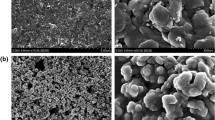Abstract
The lactose/KClO3 is a widely used pyrotechnic mixture to vaporize organic materials, such as smoke dyes. However, because of low ignition temperature of this mixture, serious precaution should be taken into account to prevent its accidental self-ignition. In order to find a safe and efficient alternative of this conventional mixture, KClO3 has been replaced by common oxidizing agents including KMnO4, KNO3, KClO4, Ba(NO3)2, PbO2 and NH4ClO4. TG and DTA analysis have been used to obtain thermal characteristic of the mixtures. Based on ignition temperature of the pyrotechnic mixtures we can divide them into four categories as follows: (1) the mixture igniting at low temperature, i.e., at about 200 °C. (2) Moderate temperature igniting mixture, in which ignition occurs at 300–400 °C. (3) High temperature igniting mixture with ignition temperature higher than 400 °C .(4) Not igniting mixtures. Also, the apparent activation energy (E), ΔG #, ΔH #, ΔS # and critical ignition temperature (T b ) of the ignition processes of low and moderate temperature igniting mixtures were obtained from the DSC experiments. Finally, among the investigated mixtures, lactose/KNO3 can be considered as a safe and efficient pyrotechnic composition for vaporization of organic materials, such as smoke dyes, due to its moderate safe ignition temperature.



Similar content being viewed by others
References
Berger B. Parameters influencing the pyrotechnic reaction. Propellants Explos Pyrotech. 2005;30:27–35.
Brown ME. Some thermal studies on pyrotechnic compositions. Therm Anal Calorim. 2001;65:323–34.
Qian XM, Wang Y, Feng CG. Investigation of thermal decomposition of KClO3/CuO/S/Mg-Al/C6Cl6 system by accelerating rate calorimeter. Acta Phys-Chim Sin. 2001;17:70–3.
Hemmila M, Hihkio M, Linnainmaa K. Evaluation of the acute toxicity and genotoxicity of orange, red, violet and yellow pyrotechnic smokes in vitro. Propellant Explos Pyrot. 2007;32:415–22.
Fathollahi M, Pourmortazavi SM, Hosseini SG. The effect of the particle size of potassium chlorate in pyrotechnic compositions. Combust Flame. 2004;138:304–6.
Hosseini SG, Pourmortazavi SM, Hajimirsadeghi SS. Thermal decomposition of pyrotechnic mixtures containing sucrose with either potassium chlorate or potassium perchlorate. Combust Flame. 2005;14:322–6.
Ellern H. Military and civilian pyrotechnic. New York: Chemical Publishing Company Inc.; 1968.
McLain JH. Pyrotechnics from the viewpoint of solid state chemistry. Philadelphia: The Franklin Institute Press; 1980.
Akhavan J. The chemistry of explosives. 2nd ed. London: The Royal Society of Chemistry; 2004.
Eslami A, Hosseini SG, Pourmortazavi SM. Thermoanalytical investigation on some boron-fuelled binary pyrotechnic systems. Fuel. 2008;87:3339–43.
Roduit B, Borgeat C, Berger B, Folly P, Andres H, Schädeli U, Vogelsanger B. UP-scaling of DSC DATA of high energetic materials, simulation of cook-off experiments. J Therm Anal Calorim. 2006;85:195–202.
Berger B, Brammer AJ, Charsley EL, Rooney JJ, Warrington SB. Thermal analysis studies on the boron–potassium perchlorate–nitrocellulose pyrotechnic system. J Therm Anal Calorim. 1997;49:1327–55.
Gunawan R, Zhang D. Thermal stability and kinetics of decomposition of ammonium nitrate in the presence of pyrite. J Hazard Mater. 2009;165:751–8.
Charsley EL, Laye PG, Brown ME. Handbook of thermal analysis and calorimetry: pyrotechnics. 1st ed. Amsterdam: Elsevier; 2003. p. 777–815.
Pineda EAG, Ferrarezi ADM, Ferrarezi JG, Hechenleitner AAW. Thermal decomposition of enalapril maleate studied by dynamic isoconversional method. J Therm Anal Calorim. 2005;79:259–62.
Ramos LA, Cavalheriro ETG, Chierice GO. Preparation, characterization and thermal decomposition of ammonium salts of dithiocarbamic acids. J Therm Anal Calorim. 2005;79:349–53.
Brown SD, Charsley EL, Goodall SJ, Laye PG, Rooney JJ, Griffiths TT. Studies on the ageing of a magnesium–potassium nitrate pyrotechnic composition using isothermal heat flow calorimetry and thermal analysis techniques. Thermochim Acta. 2003;401:53–61.
Scans FS. Thermal analysis of pyrotechnic compositions containing potassium chlorate and lactose. Combust Flame. 1974;23:363–71.
Markowitz MM, Boryta DA. The differential thermal analysis of perchlorate. J Phys Chem. 1964;68:2282–9.
Pourmortazavi SM, Hajimirsadeghi SS, Hosseini SG. Characterization of the aluminum/potassium chlorate mixtures by simultaneous TG-DTA. J Therm Anal Calorim. 2006;84:557–61.
Wendlandt WW. Thermal methods of analysis. 2nd ed. New York: Wiley; 1974.
Koch EC, Clement D. Special materials in pyrotechnics: VI. Silicon—an old fuel with new perspectives. Propellants Explos Pyrotech. 2007;32:205–12.
Hosseini SG, Eslami A. Thermoanalytical investigation of relative reactivity of some nitrate oxidants in tin-fueled pyrotechnic systems. J Therm Anal Calorim. 2010;101:1111–19.
Herbstein FH, Kapon M, Weissman A. Old and new studies of the thermal decomposition of potassium permanganate. J Therm Anal Calorim. 1991;41:303–22.
Kissinger HE. Reaction kinetics in differential thermal analysis. Anal Chem. 1957;29:1702–6.
Lehmann B, Karger-Kocsis J. Isothermal and non-isothermal crystallisation kinetics of pCBT and PBT. J Therm Anal Calorim. 2009;95:221–6.
Hatakeyama T, Quinn FX. Thermal analysis, fundamentals and applications to polymer science fundamentals and applications to polymer science. New York: Wiley; 1994.
ASTM E698-05. Standard test method for Arrhenius kinetic constants for thermally unstable materials. doi:10.1520/E0698-05.
Criado JM, Perez-Maqueda LA, Sanchez-Jimenez PE. Dependence of the preexponential factor on temperature. J Therm Anal Calorim. 2005;82:671–5.
Hosseini SG, Eslami A. Orthogonal array design method for optimization experiments of sodium azide microencapsulation with stearic acid. Prog Org Coat. 2010;68:313–8.
Eslami A, Hosseini SG, Asadi V. The effect of microencapsulation with nitrocellulose on thermal properties of sodium azide particles. Prog Org Coat. 2009;65:269–74.
Guo S, Wang Q, Sun J, Liao X, Wang Z-S. Study on the influence of moisture content on thermal stability of propellant. J Hazard Mater. 2009;168:536–41.
Wang T, Lu YX, Zhu ML, Zhang JS, Ji SJ. DSC research on critical temperature in thermal explosion synthesis reaction Ti3 + Al → TiAl3. J Therm Anal Calorim. 2002;67:605–11.
Zhang TL, Hu RZ, Xie Y, Li FP. The estimation of critical temperatures of thermal explosion for energetic materials using non-isothermal DSC. Thermochim Acta. 1994;244:171–6.
Tabak A. Structural analysis of reactive dye species retained by the basic alumina surface. J Therm Anal Calorim. 2009;95:31–6.
Bayer KH. AMCP 706-185. Military pyrotechnics series, Part 1, theory and application. United State Army Material Command, Washington; 1967.
Author information
Authors and Affiliations
Corresponding author
Rights and permissions
About this article
Cite this article
Eslami, A., Hosseini, S.G. Improving safety performance of lactose-fueled binary pyrotechnic systems of smoke dyes. J Therm Anal Calorim 104, 671–678 (2011). https://doi.org/10.1007/s10973-010-1062-8
Received:
Accepted:
Published:
Issue Date:
DOI: https://doi.org/10.1007/s10973-010-1062-8




